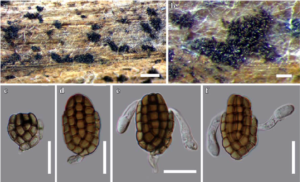Dictyosporium thailandicum D’ souza, D.J. Bhat & K.D. Hyde.
Index Fungorum number: IF551063, Facesoffungi number: FoF 00394, Fig. 1
Etymology: The specific epithet thailandicum refers to Thailand the country of origin.
Holotypus: MFLU 14–0240
Saprobic on submerged wood in flowing stream. Mycelium partly superficial, partly immersed, composed of smooth, septate, branched, light brown 1.5–3.2μm wide, hyphae. Asexual morph Sporodochia 350–500μm wide, black, scattered. Conidiophores 6.8–11 × 4.3–10.6 μm, micronematous, mononematous, cylindrical, light brown, smooth-walled. Conidiogenous cells 4.2–5×5–5.7μm terminal, integrated. Conidia 15.4–34.5×14.5–20.6μm (x=30.6× 19μm, n=50), acrogenous, solitary, dictyoseptate, cheiroid, smooth-walled, complanate, light brown when young, turning dark brown to black at maturity, with 28–32 cells per conidium and 6–9 cells per row, consisting of 5 rows of cells; outer rows shorter than inner rows, with 6–8 cells, with two hyaline, smooth, tubular, elongated appendages in the above half, 20.6–26×5.1–6.1μm.Sexual morph Undetermined.
Culture characters: Conidia germinate on water agar (WA) within 24 h. Colonies on PDA, slow growing, covering 9 cm Petri-dish in 2 months at 24–28 °C, yellow to pale brown, sporulating in 45 days.
Material examined: THAILAND. Chiang Rai Province, Mae Fah Luang University stream, on submerged wood, 15 September 2013, M. D’souza, MJD-2 (MFLU 14–0240, holotype); ex-type living culture, MFLUCC 13-0773. GenBank ITS: KP716706; LSU: KP716707.
Notes: Morphologically D. thailandicum is comparable to D. alatum Emden, D. bulbosum Tzean & J.L. Chen, D. elegans Corda and D. strelitziae Crous & A.R. Wood (Table 1). Dictyosporium thailandicum is very similar to D. alatum in having the same-sized conidia, appendages, shape and rows of cells, but differs in the number of cells per row. Dictyosporium alatumhas 4–6 cells in a row, whereas D. thailandicum has 6–9. Further, the rows of cells in D. alatum may vary from 4–7 and, in contrast, D. thailandicum has consistently 5 rows of cells except when in culture; D. thailandicum may occasionally possess 3 or 4 rows of cells. In our phylogenetic analysis, D. thailandicum was nested in a clade together with D. alatum, D. bulbosum, D. elegans and D. strelitziae with a strong bootstrap support. Dictyosporium thailandicum is phylogenetically close to D. strelitziae, but morphologically this species differs from D. thailandicum in having longer conidia, and a larger number of cells in the conidium.

Fig. 1 Dictyosporium thailandicum (holotype) a, b Condiomata on the substrate c-f conidia. Scale bars: a=500μm, b=100μm, c-f=20μm.

